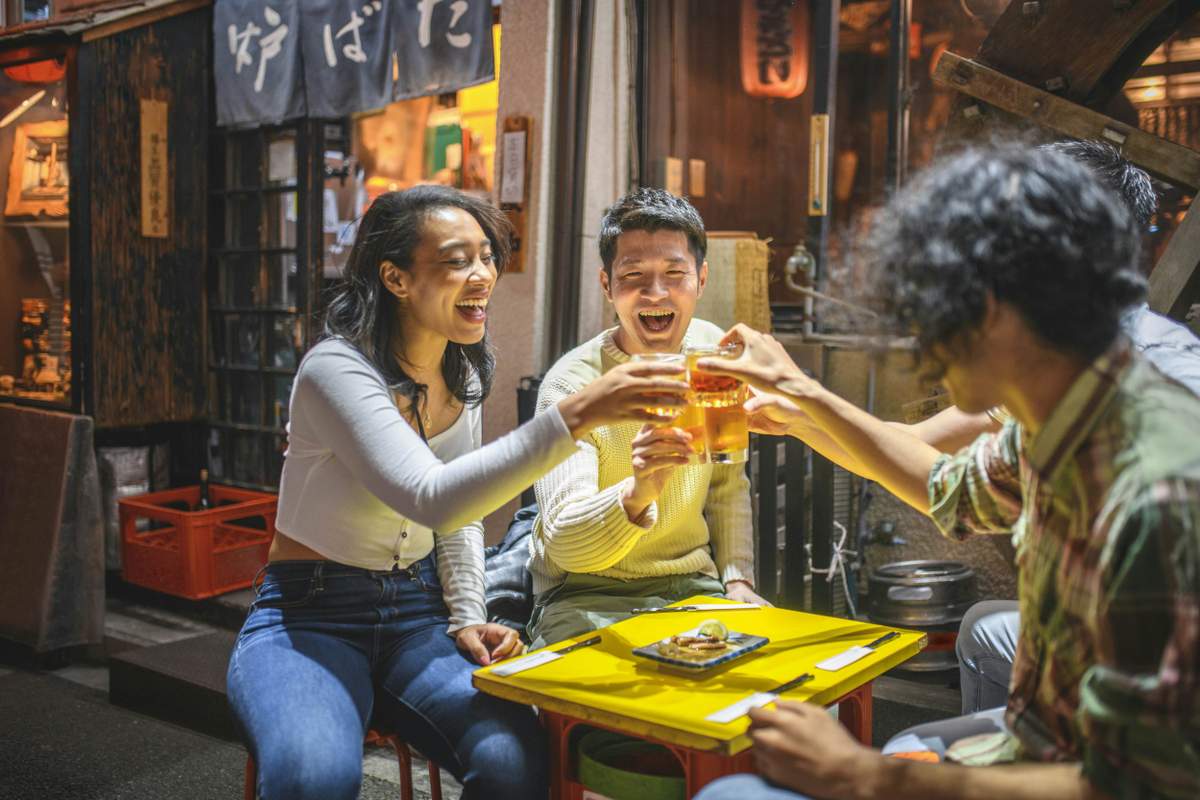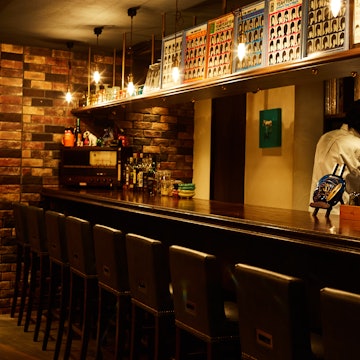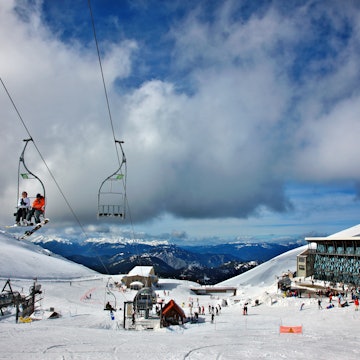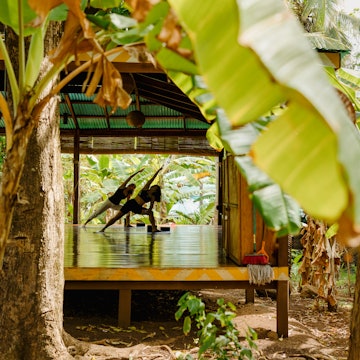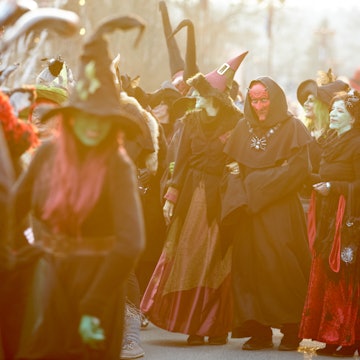

Discover everything you need to know for a visit to Kyoto Imperial Palace with these tips. Rintaro Kanemoto for Lonely Planet
Dominated by the Imperial Palace and its vast surrounding park and gardens, this area was once the political and ruling heart of Kyoto (and, indeed, Japan). Now, it is more known as a tranquil and spectacularly green retreat in the center of the city, just to the north of the bustling downtown.
The Kyoto Imperial Palace Park is central Kyoto’s largest park by far. While it once drew dignitaries and the ruling elite, it now attracts a more varied crowd of picnicking families, weekend runners, and tourists taking in the sights. The Kyoto Imperial Palace was the seat of the imperial family for many centuries, while the neighboring Sentō Imperial Palace was a retreat for retired emperors. Both remain grand monuments to Kyoto’s historic importance, with fabulous gardens for visitors to enjoy.
While it is true that Kyoto’s main tourist attractions and most famous spots tend to be around the edges of the city, there are still plenty of things to see and do in Kyoto Imperial Palace and the surrounding area.
When should I go to Kyoto Imperial Palace?
Visit the Kyoto Imperial Palace at any time of the year – it’s beautiful through all seasons. Most people visit during plum or cherry blossom seasons. On weekdays it is best to visit early in the morning when you’ll find fewer crowds. The weather will also be a little cooler in the morning during warmer seasons.
How much time should I spend at Kyoto Imperial Palace?
To best explore Kyoto Imperial Palace and the surrounding attractions, plan to spend roughly 2 to 3 hours. The free guided tours usually last about 1 hour, plus any additional time you spend strolling around the beautiful gardens.

Entry fees
Entrance to the Kyoto Imperial Palace grounds is free, and you do not need a ticket. Free guided tours are offered twice daily – you register ahead of time or when you arrive. You will need a valid form of identification, and you can register outside of the Kikyo-mon gate of the Imperial Palace.
No tours are given on Sundays, Mondays, national holidays (except when a holiday falls on a Saturday), afternoons from July 21st to August 31st and from December 28th to January 4th.
How to get there
Depending on the time of year, weather and your itinerary, you’ll find that there are still many ways to get to Kyoto Imperial Palace.
Subway: Take the Karasuma Line (green line) on the Kyoto Subway and get off at Marutamachi Station (it’s just one stop north of the city center). From here, it’s about a 10-minute walk to Kyoto Imperial Palace.
Bus: Take Kyoto City Bus #9, #50, or #101 to the Imperial Palace (Kōkyo-mae) bus stop, which will drop you off at the palace entrance.
Bicycle: Several places to rent bikes are near tourist areas, like Kyoto Station. A bike ride to Kyoto Imperial Palace from central Kyoto would take about 10-15 minutes.
On Foot: From Kyoto Station or downtown Kyoto, a walk to Kyoto Imperial Palace will take about 30-40 minutes.
Taxi: Whether you’re staying downtown or more central Kyoto, a ride to Kyoto Imperial Palace will take 10-20 minutes, depending on where you’re coming from.
Top things to see at Kyoto Imperial Palace
Imperial Palace
Near the middle of Kyoto Imperial Palace Park is the Gosho or Kyoto Imperial Palace (京都御所). This was the residence of Japan’s imperial family until both the emperor and capital relocated from Kyoto to Tokyo in 1868. While the palace itself can’t be entered, it takes about an hour or so to wander around the grounds and admire the grand buildings and sumptuous gardens. There are English-language signs explaining some of the history and details, but it’s best to follow the free downloadable self-guided audio tour.
Planning tip: There are free guided tours in English twice daily. The entrance is at the Seishomon Gate on the west side of the palace grounds.
Sentō Imperial Palace
Across from and slightly less grand than the Kyoto Imperial Palace is the Sentō Imperial Palace (仙洞御所). Originally built in 1630 as a retirement residence for Emperor Gomizuno, it was subsequently used as a retirement home for other emperors, although the current structure dates back to 1867. The impressive strolling gardens date back to the building’s original construction, however, and can be viewed by joining a free tour (in Japanese, but with an English audio guide).
Tours take place twice a day (10am and 1:30pm), take just over an hour and must be applied for in advance, either online (visit kunaicho.go.jp) or via the Kunaichō, the Imperial Household Agency, which has an office inside the northwest corner of the Imperial Palace Park. You need to be over 18 and have your passport with you.

Kyoto Imperial Palace Park
Also known as Kyoto Gyoen National Garden (京都御苑), this enormous site is located almost in the exact center of the city, and is home to both the Kyoto Imperial Palace and Sentō Imperial Palace. A green oasis of calm, Kyoto Imperial Palace Park is a lovely place to take a walk, picnic or people-watch, with forested pathways, wide gravel boulevards, landscaped gardens and grassy lawns that are great for frolicking and games.
Planning tip: Although the park is beautiful at any time of year, it is particularly popular in early spring during the plum (late February) and cherry blossom season (late March/early April).
Kaninnomiya Mansion
History buffs should not miss the former Kaninnomiya residence in the park’s southwestern corner. This renovated, affluent old family home is often overlooked, but it is free to enter and enshrined in picturesque gardens.
The only entirely preserved noble family mansion from the Edo period within Kyoto Imperial Park gives visitors a look into the lives of Japanese court nobles and their residences. It is a great way to learn more about the aristocratic culture of Japan during this period and see original features like the polished zelkova wood floorboards and parts of the original garden.
Nearby attractions
Shimogamo-jinja
A UNESCO World Heritage Site, this Shintō shrine dates back to the 7th century, making it one of the oldest and most important in Japan. Nestled close to the convergence of the Kamogawa and Takanogawa, the Shimogamo-jinja (下鴨神社) main shrine is best approached along a path through the atmospheric Tadasu-no-mori, a forest where 600-year-old trees grow and where it is said lies cannot be concealed.
A number of smaller shrines dot the site. Kawai-jinja bestows visitors with beauty, Aioi-no-Yashiro is for luck in love, and at Mitarashi-sha, people wade through the nearby stream in the summer for purification and respite from the heat. You can dip your omikuji (fortune paper) in the water to reveal its hidden message (use a translating app to decipher it!).
Planning tip: To get to Shimogamo-jinja, City Bus 4 stops just outside the shrine, or it’s a 15-minute walk from Demachiyanagi Station on the Keihan line.

Kyoto Botanical Gardens
A sprawling site covering 24 hectares and home to over 12,000 plants, trees and flowers, the wonderful Kyoto Botanical Gardens (京都府立植物園) is a must for anyone looking for a quiet few hours in a serene environment – all for only ¥200 (US$1.30).
There is a wide variety of areas to explore, meaning that whenever you go, something will be in radiant full bloom. The enormous flagship conservatory is well worth the additional ¥200 (US$1.30) entry fee for its fascinating botanical displays that take you on a whistle-stop tour around the world, from deserts to tropical rainforests and alpine biomes.
Planning tip: The gardens tend to be skipped by most visitors to the city, so it is a great place to escape the crowds.
Nishijin
This small district to the northwest of Kyoto Imperial Palace Park is famous for being the city’s traditional textile-making quarter. Spread over several blocks, the streets of Nishijin (西陣) are filled with machiya (traditional townhouses) and have a real old-fashioned feel, making it a great place to wander.
Several small museums and galleries showcase the area’s long-standing weaving industry. Most tourists head to the Nishijin Textile Center (on the southwest corner of the Horikawa-dōri and Imadegawa-dōri intersection) to watch weaving demonstrations, see how kimonos are created and maybe purchase something.
Planning tip: Orinasu-kan is a much quieter and more evocative workshop, museum and shop where you can see the elegant fabrics and craft-making process up close.

Daitoku-ji
Daitoku-ji is the head temple of the Rinzai sect’s Daitoku-ji school of Japanese Zen Buddhism. Located at the eastern end of the complex, the headquarters were founded in 1319, burnt down during the Ōnin War a century later, were rebuilt and later developed associations with the art of the tea ceremony and infamous warlords such as Toyotomi Hideyoshi.
The impressive main buildings are not usually open to the public (although they can be glimpsed through the pines), but a number of the surrounding sub-temples are – what’s more, they’re all quite distinct from one another, making the district well worth a thorough exploration.
Planning tip: Separate entry fees are required for each temple.

Funaoka Onsen
Kyoto is not a city blessed with many hot springs, but Funaoka Onsen (船岡温泉) is one of the best places for a rejuvenating soak. This quaint old sentō (public bathhouse) gives bathers plenty of options, with an outdoor bath, a cypress-wood tub, herbal waters, an ice bath, an electric bath and a sauna, among others.
It’s open daily with towels to buy or rent. Find it on Kuramaguchi-dōri behind some large rocks.
Planning tip: Baths are separated by gender. Use the showers or washbowls to wash beforehand, being careful to rinse off any soap suds, and take a small towel to protect your modesty or to dry off a bit afterward.
Getting around
Kyoto is an easily navigable city, with an excellent public transportation system and mostly flat streets, making it a great destination for exploring by bike or on foot.
Subway: The subway is useful for this part of the city; the Karasuma line provides decent access to most sights, including the Imperial Palace Park and the Kyoto Botanical Gardens, and conveniently connects directly to Kyoto Station.
On foot: You can walk! If you don’t mind strolling, many other sights are within walking distance of a train station.
City buses: Will get you closest to the main attractions, especially those in the northwest, such as Daitoku-ji and Kamigamo-jinja. Tourist information centers will help you out with bus routes and timetables.
By bicycle: The sights are quite spread out in this part of town, but the streets are flat, so a bicycle is also a great way of getting around.

Where to eat and drink near Kyoto Imperial Palace
Kyoto is one of the world’s great food cities, but the sheer choice of establishments – particularly downtown – can make eating out a bewildering ordeal. For straightforward but reliable options, the restaurant floors of Takashimaya and Daimaru offer a good selection of high-quality eateries in a compact area.
For a quick meal close to the Kyoto Imperial Palace, check out Grand Burger, which has large juicy burgers on toasted buns, plus good sides. The quick, friendly service and quiet back-street location make this a local favorite.
There is an excellent shōjin-ryōri (Zen Buddhist vegetarian cuisine) restaurant called Izusen on the grounds of Daiji-in, in the southern section of Daitoku-ji. Shōjin-ryōri is the traditional food of Buddhist monks, with beautifully presented seasonal and delicious small dishes consisting of vegetables, tofu, mushrooms and rice. Courses are not super cheap (around ¥4000 to ¥5000 = US$27 to US$34), but are well worth it for the excellent vegetarian food and overall experience.
Planning tip: Download the Tabelog app for the best restaurant recommendations during your trip to Japan.
Where to stay
The area around the Kyoto Imperial Palace offers a blend of peaceful surroundings and convenience to the area’s main attractions. There are plenty of places to rest and recharge.
A short walk from the Imperial Palace Park, Kyoto Brighton Hotel offers large rooms and refined luxury, with a free shuttle service to/from Karasuma-Oike Station. For a cheap but comfortable budget option, consider Kyoto Garden Palace, which is directly across from the park and offers bicycles for guests to use.
Tips and tricks
Here are a few tips and tricks for traveling around the Imperial Palace area in Kyoto:
Mind your manners when traveling around Kyoto, especially when visiting temples and shrines. Don’t talk loudly when visiting, and be sure to follow any other rules, including removing your shoes and following any photograph policies.
Pack shoes you can easily slip on and off for traditional guesthouses or temples.
Do not eat and walk – this is considered disrespectful. If you grab food at Nishiki Market or any other establishment, stand near that spot and eat before continuing your journey!
In Tokyo, people stand on the left side of escalators and walk up the right. Osaka does things the opposite way around. In Kyoto, it isn’t always clear-cut, but the majority follow Osaka rules: stand right, walk left.
Airports, stations, cafes, hotels and busy tourist areas often have free wi-fi, but it can be unreliable. Consider renting a mobile wi-fi router or buying a SIM card at the airport when you arrive.
Tap water is safe in Kyoto. For refill points, download the MyMizu app.
Is Kyoto Imperial Palace accessible?
The grounds and gardens of Kyoto Imperial Palace are accessible for those in wheelchairs, scooters, etc., because of the paved pathways. There is a free wheelchair rental at the entrance, but it is recommended that you call ahead for availability.






